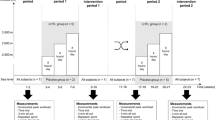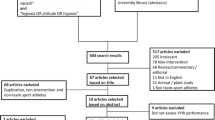Abstract
Elite athletes often undertake altitude training to improve sea-level athletic performance, yet the optimal methodology has not been established. A combined approach of live high/train low plus train high (LH/TL+TH) may provide an additional training stimulus to enhance performance gains. Seventeen male and female middle-distance runners with maximal aerobic power \( \left( {\dot{V}{\text{O}}_{{2{ \max }}} } \right) \) of 65.5 ± 7.3 mL kg−1 min−1 (mean ± SD) trained on a treadmill in normobaric hypoxia for 3 weeks (2,200 m, 4 week−1). During this period, the train high (TH) group (n = 9) resided near sea-level (~600 m) while the LH/TL+TH group (n = 8) stayed in normobaric hypoxia (3,000 m) for 14 hours day−1. Changes in 3-km time trial performance and physiological measures including \( \dot{V}{\text{O}}_{{2{ \max }}} , \) running economy and haemoglobin mass (Hbmass) were assessed. The LH/TL+TH group substantially improved \( \dot{V}{\text{O}}_{{2{ \max }}} \) (4.8%; ±2.8%, mean; ±90% CL), Hbmass (3.6%; ±2.4%) and 3-km time trial performance (−1.1%; ±1.0%) immediately post-altitude. There was no substantial improvement in time trial performance 2 weeks later. The TH group substantially improved \( \dot{V}{\text{O}}_{{2{ \max }}} \) (2.2%; ±1.8%), but had only trivial changes in Hbmass and 3-km time-trial performance. Compared with TH, combined LH/TL+TH substantially improved \( \dot{V}{\text{O}}_{{2{ \max }}} \) (2.6%; ±3.2%), Hbmass (4.3%; ±3.2%), and time trial performance (−0.9%; ±1.4%) immediately post-altitude. LH/TL+TH elicited greater enhancements in physiological capacities compared with TH, however, the transfer of benefits to time-trial performance was more variable.



Similar content being viewed by others
References
Batterham AM, Hopkins WG (2006) Making meaningful inferences about magnitudes. Int J Sports Physiol Perform 1:50–57
Bonetti DL, Hopkins WG (2009) Sea-level exercise performance following adaptation to hypoxia: a meta-analysis. Sports Med 39:107–127
Clark SA, Quod MJ, Clark MA, Martin DT, Saunders PU, Gore CJ (2009) Time course of haemoglobin mass during 21 days live high:train low simulated altitude. Eur J Appl Physiol 106:399–406
Cohen J (1988) Statistical power analysis for the behavioural sciences. Lawrence Erlbaum Associates, Hillsdale
di Prampero PE (1986) The energy cost of human locomotion on land and in water. Int J Sports Med 7:55–72
di Prampero PE, Ferretti G (1990) Factors limiting maximal oxygen consumption in humans. Respir Physiol 80:113–127
Dick FW (1992) Training at altitude in practice. Int J Sports Med 13(Suppl 1):S203–S206
Dufour SP, Ponsot E, Zoll J, Doutreleau S, Lonsdorfer-Wolf E, Geny B, Lampert E, Fluck M, Hoppeler H, Billat V, Mettauer B, Richard R, Lonsdorfer J (2006) Exercise training in normobaric hypoxia in endurance runners. I. Improvement in aerobic performance capacity. J Appl Physiol 100:1238–1248
Gore CJ, Hahn AG, Burge CM, Telford RD (1997) VO2max and haemoglobin mass of highly trained athletes during high intensity training. Int J Sports Med 18:477–482
Gore CJ, Rodriguez FA, Truijens MJ, Townsend NE, Stray-Gundersen J, Levine BD (2006) Increased serum erythropoietin but not red cell production after 4 wk of intermittent hypobaric hypoxia (4,000–5,500 m). J Appl Physiol 101:1386–1393
Hahn AG, Gore CJ, Martin DT, Ashenden MJ, Roberts AD, Logan PA (2001) An evaluation of the concept of living at moderate altitude and training at sea level. Comp Biochem Physiol 128:777–789
Hopkins WG (2006) Spreadsheets for analysis of controlled trials, with adjustment for a subject characteristic. Sportscience 10:46–50
Hopkins WG, Hewson DJ (2001) Variability of competitive performance of distance runners. Med Sci Sports Exerc 33:1588–1592
Hopkins WG, Marshall SW, Batterham AM, Hanin J (2009) Progressive statistics for studies in sports medicine and exercise science. Med Sci Sports Exerc 41:3–12
Hoppeler H, Klossner S, Vogt M (2008) Training in hypoxia and its effects on skeletal muscle tissue. Scand J Med Sci Sports 18(Suppl 1):38–49
Levine BD, Stray-Gundersen J (1997) “Living high-training low”: effect of moderate-altitude acclimatization with low-altitude training on performance. J Appl Physiol 83:102–112
Levine BD, Stray-Gundersen J (2006) Dose-response of altitude training: how much altitude is enough? Adv Exp Med Biol 588:233–247
Levine BD, Stray-Gundersen J, Gore CJ, Hopkins WG (2005) Point:Counterpoint. Positive effects of intermittent hypoxia (live high:train low) on exercise performance are mediated primarily by augmented red cell volume. J Appl Physiol 99:2053–2057
Meeuwsen T, Hendriksen IJ, Holewijn M (2001) Training-induced increases in sea-level performance are enhanced by acute intermittent hypobaric hypoxia. Eur J Appl Physiol 84:283–290
Noakes TD, Myburgh KH, Schall R (1990) Peak treadmill running velocity during the VO2 max test predicts running performance. J Sports Sci 8:35–45
Nummela A, Rusko H (2000) Acclimatization to altitude and normoxic training improve 400-m running performance at sea-level. J Sports Sci 18:411–419
Prommer N, Schmidt W (2007) Loss of CO from the intravascular bed and its impact on the optimised CO-rebreathing method. Eur J Appl Physiol 100:383–391
Robertson EY, Saunders PU, Pyne DB, Aughey RJ, Anson J, Gore CJ (2010) Reproducibility of performance changes to simulated live high/train low altitude. Med Sci Sports Exerc 42:394–401
Roels B, Millet GP, Marcoux CJ, Coste O, Bentley DJ, Candau RB (2005) Effects of hypoxic interval training on cycling performance. Med Sci Sports Exerc 37:138–146
Rusko HK, Tikkanen HO, Peltonen JE (2004) Altitude and endurance training. J Sports Sci 22:928–945
Saunders PU, Telford RD, Pyne DB, Cunningham RB, Gore CJ, Hahn AG, Hawley JA (2004) Improved running economy in elite runners after 20 days of simulated moderate-altitude exposure. J Appl Physiol 96:931–937
Saunders PU, Telford RD, Pyne DB, Hahn AG, Gore CJ (2009) Improved running economy and increased hemoglobin mass in elite runners after extended moderate altitude exposure. J Sci Med Sport 12:67–72
Stray-Gundersen J, Chapman RF, Levine BD (2001) “Living high-training low” altitude training improves sea level performance in male and female elite runners. J Appl Physiol 91:1113–1120
Terrados N, Melichna J, Sylven C, Jansson E, Kaijser L (1988) Effects of training at simulated altitude on performance and muscle metabolic capacity in competitive road cyclists. Eur J Appl Physiol Occup Physiol 57:203–209
Truijens MJ, Toussaint HM, Dow J, Levine BD (2003) Effect of high-intensity hypoxic training on sea-level swimming performance. J Appl Physiol 94:733–743
Ventura N, Hoppeler H, Seiler R, Binggeli A, Mullis P, Vogt M (2003) The response of trained athletes to six weeks of endurance training in hypoxia or normoxia. Int J Sports Med 24:166–172
Wehrlin JP, Zuest P, Hallen J, Marti B (2006) Live High-Train Low for 24 days increases hemoglobin mass and red cell volume in elite endurance athletes. J Appl Physiol 100:1938–1945
Acknowledgments
The authors gratefully acknowledge the subjects for their time and efforts; support of staff in the Department of Physiology at the Australian Institute of Sport, particularly Tegan Meredith for collection and processing of the haematological data; and financial support from the Faculty of Health, University of Canberra, and the Applied Research Centre, Australian Institute of Sport.
Author information
Authors and Affiliations
Corresponding author
Additional information
Communicated by Guido Ferretti.
Rights and permissions
About this article
Cite this article
Robertson, E.Y., Saunders, P.U., Pyne, D.B. et al. Effectiveness of intermittent training in hypoxia combined with live high/train low. Eur J Appl Physiol 110, 379–387 (2010). https://doi.org/10.1007/s00421-010-1516-5
Accepted:
Published:
Issue Date:
DOI: https://doi.org/10.1007/s00421-010-1516-5




